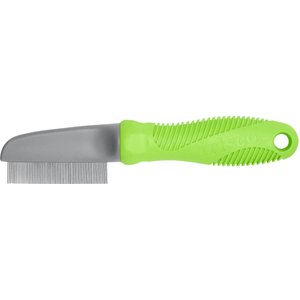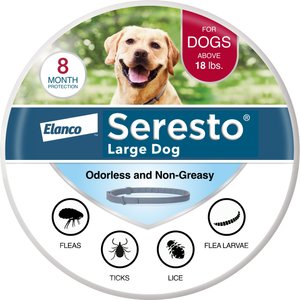Sigh, it’s true; humans can get fleas from dogs and other pets. If you’ve ever walked across the carpet in your home and noticed a dark speck on your white socks that suddenly appears then vanishes, there’s a good chance that speck could have been a flea.
While pets undoubtedly enrich our lives in innumerable ways, this close proximity has put us at greater risk for sharing ectoparasites–such as the flea. We spoke to a vet expert on what you need to know about fleas on humans.
Does a Dog Flea Become a Human Flea?
Technically yes, a dog flea becomes a human flea, but there’s a caveat. There are thousands of species of fleas, and most animals have a specific type of fleas that prefers that animal as its host. While the flea that dogs typically carry can–and does–jump over to humans and bite us, the dog flea cannot survive on humans.
First, dog fleas need dog blood to eat. Second, humans aren’t hairy enough to provide ample hiding coverage or the warm environment that dog fleas seek in a home.
Most fleas figure this out quickly and will return to your pup or seek a safer spot in your home. This makes treating your home a key part of flea prevention/pest control and not something to overlook.
Signs of Flea Bites on Humans
If you see dark small bugs that hop instead of flying and you find yourself with bites, it is most likely fleas.
Unlike mosquito bites, flea bites remain small. If a flea bites you, you might see one or more of the following:
- Bites that appear as small, red bumps
- A red “halo” around the bite center
- Bites in groups of three or four, or in a straight line
- Bites that appear around the ankles or legs
While not common, fleas can transmit diseases to animals and humans via bites or when swallowed. Diseases include:
- Murine typhus: Cats can come into contact with fleas carrying Murine typhus, which can then transfer to humans via a bite from an infected flea. Symptoms include headache, fever, nausea and body aches.
- Mycoplasma haemofelis: This parasitic bacterial disease is transmitted to cats through flea bites. Humans can get it, too. Signs include lethargy, weight loss, anemia and more.
- Tapeworms: Tapeworms are extremely uncommon in adults; however, children can get infected by accidentally swallowing an infected flea while playing outdoors, per the CDC.
- Cat scratch disease: People typically become infected with Bartonella henselae through bites or scratches of domestic or feral cats (particularly kittens), the CDC reports. Cat scratch disease occurs most often in children under 15. Signs include low-grade fever; enlarged, tender lymph nodes, and a small raised, tender bump at the site of the scratch.
-
How to Treat Human Flea Bites
They’re gross to think about because when fleas bite you, they secrete saliva into your bloodstream. That flea saliva triggers your body to release histamine and send it to the bite, which in turn causes itchiness and swelling.
Once you get past the ick factor, simply washing the area with soap and water, applying a topical over-the-counter antihistamine cream as necessary, and avoiding the temptation to scratch will lead to quicker relief and healing.
On a dog, the female flea can lay eggs after enjoying some of your fur baby’s blood. Fortunately, that doesn’t happen to humans and perhaps even more fortunately, fleas cannot live in human hair.
What To Do if Your Dog Has Fleas
In dogs, fleas can lead to hot spots or cause anemia in cases of heavy flea infestations, especially in young or debilitated dogs. In addition, certain fleas can carry several diseases, including the bubonic plague, and act as vectors to spread one of the most common tapeworms of the dog and cat.
If you do spot these pests on yourself, it’s likely your dog is the source of the flea problem; so, it’s best to initiate treatment, as well as get a fecal exam for your dog, to get rid of fleas right away.
To treat your four-legged friend, you’ll first need to comb their hair with a flea comb. Next, you’ll bathe your dog with flea shampoo (as long as your dog is old enough for one).
Once you’ve conquered the flea infestation, both in your home and on your dog, you’ll need to move on to the flea preventative stage.
How To Prevent Fleas on Your Dog
For dog flea treatments, specifically, popular vet-recommended options include Frontline Plus, Seresto and K9 Advantix II. Be mindful that you’re purchasing the correct medication dose, as it varies based on your dog’s size.
Learn more about how to choose the best flea and tick treatment for dogs. But remember it’s always best to check with your vet.
How to Get Rid of Fleas in Your Home Environment
Remember, however, that most products are effective against only the adult flea and you need to address the problem during all stages of the life cycle.
Products that contain Insect Growth Regulators (IGRs) will help destroy the larvae. Before applying any environmental product, vacuum all floors, rugs, carpets, upholstered furniture and crevices around the baseboards and cabinets to help stimulate the pre-adult fleas to emerge from their protective cocoons. And be sure to discard the vacuum cleaner bag after its use.
The good news is that it’s uncommon to have a full flea infestation in your actual bed. This is because fleas in your bed are likely there because they fell off of your dog.
However, it’s imperative you wash all human bedding, throw rugs and pet beds with laundry detergent and hot water to ensure you completely eradicate the fleas. If you treat the floors but skip the rest, the flea problem will persist.
How to Get Rid of Fleas in Your Yard
Fleas prefer tall grass and shaded areas near decks, woodpiles or storage buildings, so concentrate on these areas.
To kill fleas, spray a product containing an IGR and repeat every 14-21 days for three to five applications.
Help! The Fleas Came Back!
That’s because before fleas reach their adult stage, they can survive within a cocoon for up to nine months. During this time, they are resistant to insecticides applied to the environment.
This is important to remember because adult fleas may emerge into the environment a considerable length of time after you apply insecticides in your home. It doesn’t mean you did something wrong. It just means you need to retreat your home and yard and ensure your dog remains on a flea preventative.
More about pesky fleas (and banishing them!):
Share:






















